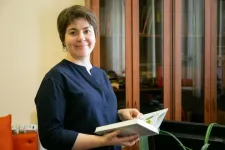(Press-News.org) Over the past years, global data traffic has experienced a boom, with over 12.5 billion connected devices all over the world. The current world-wide deployment of the 5G telecommunications standard is triggering the need for smaller devices with enhanced performances, such as higher speed, lower power consumption and reduced cost as well as easier manufacturability.
In search for the appropriate technology, photonic devices emerged as the leading technology for the evolution of such information and communication technologies, already surpassing the capabilities of current microelectronics and CMOS technologies.
Optical communication systems rely on three basic components: modulators, waveguides and photodetectors. The modulation of light is key for photonic integrated circuits because it allows to transmit multiple signals simultaneously over a single channel. More specifically, electro-absorption (EA) modulators modulate the amplitude of the light passing through the optical waveguide.
So far, silicon and graphene are winning the race since they are proving to be the most scalable, cost-effective and CMOS compatible materials for optical modulation and detection. Graphene-based modulators have already shown broadband optical bandwidth and temperature stability, but in occasions, they have been incapable of showing both high-speed and high modulation efficiencies simultaneously, due to the limited quality of graphene and a combination between the graphene and the dielectric material.
Now, in a study published in Nature Communications, ICFO researchers Hitesh Agarwal, Bernat Terrés, Lorenzo OrsinI, led by ICREA Professor at ICFO Frank Koppens, in collaboration with researchers from Universita di Pisa, CNIT, Ghent University-IMEC, and NIMS have reported on a novel EA modulator capable of showing a 3-fold increase in static and dynamic modulation efficiency while maintaining the high-speed, a value that surpasses those for previously reported graphene EA modulators.
To achieve this, the team of researchers developed a high-quality graphene-based electro-absorption modulator by combining high-quality graphene and a high-k dielectric, also used in microelectronics. The high quality of the graphene was achieved by integrating it with the 2d-material dielectric hexagonal boron nitride (hBN). Interestingly enough, the team was then able to add the high-k dielectric material HfO2 sandwiched in between two layers of boron nitride, which permitted operating with much smaller voltages, and, at the same time, achieving symmetric and hysteresis-free due to the high quality of the graphene. By doing this, the dielectric combination was able to enhance the EA modulator capacitance without compromising the robustness of the device against high voltages, preserve the high mobility of charge carries (increasing the modulation efficiency) while maintaining low levels of doping.
As Hitesh Agarwal, researcher at ICFO and first author of the study, comments, "Because one of the major bottlenecks for the integration of graphene into CMOS fab lines is its incompatibility with high-k oxides, this motivated us to build the structure of hBN-HfO2-hBN. Not only we managed to achieve high modulation efficiency (due to high-K dielectric), but also higher speed (due to increased mobility)."
"We have been waiting for a while to see the outstanding fundamental capabilities of graphene to unleash in applications", Bernat Terrés, Postdoc researcher at ICFO and corresponding author of the work, adds. He also stresses that "Optoelectronics is one of the first where this 2D material overcomes current state-of-the-art technologies, bringing an encouraging prospect for other commercial applications".
In summary, the device was capable of outperforming previous modulators, operating at high-speeds while, maintaining a very high modulation efficiency, low power consumption, achieving a record breaking 39GHz bandwidth, with operations up to 40Gbps speed, and consequently overcoming the fundamental limitations obtained so far with double layer graphene systems.
The compatibility of this device with silicon technology and microelectronics could facilitate the scaling improvements that we face nowadays for the photonic industry as well as implement this type of technology for a much greater range of functionalities in electronic and optoelectronic applications. Such results could definitely benefit applications for high-speed and low-latency optical networks such as autonomous vehicles, remote surgery, IoT, to name a few.
Collaborator of the study, Marco Romagnoli, researcher at CNIT and work-package leader of the Graphene Flagship, comments, "This new scientific result of ultrafast electro absorption modulator paves the way towards the continuous race for speed demonstrating the highest electro-optical bandwidth achieved with graphene and 2D materials. In addition, this work is also the first example of full 3D integration entirely realized by assembling different types of 2D materials demonstrating the potentiality of these new routes in microfabrication of integrated circuits."
In addition, Wolfgang Templ, from Nokia Bell Labs highlights "This work shows that the discussed 2D-3D dielectric integration of high-quality double layer encapsulated Graphene structures can open the way to the realisation of new high performing and micro-sized electro absorption modulators (EAMs) which can be combined with Si-based electronic into most advanced highly integrated photonic circuits".
Finally, Frank Koppens, ICREA Professor at ICFO and work-package leader of the Graphene Flagship, pinpoints "Data traffic is growing rapidly and will benefit society greatly, for example by enabling autonomous vehicles. The power consumption of high data traffic rates, however, is a key challenge that needs to be addressed. I'm happy to see that graphene-based modulators with much lower power consumption, as shown in this work, can tackle two societal challenges at the same time."
INFORMATION:
Link to the paper: https://www.nature.com/articles/s41467-021-20926-w
Link to the research group led by ICREA Prof at ICFO Frank Koppens: https://www.icfo.eu/lang/research/groups/groups-details?group_id=31
Link to graphene at ICFO: http://graphene.icfo.eu/
Link to the graphene Flagship: https://graphene-flagship.eu/
ADELPHI, Md. -- The Army of the future will involve humans and autonomous machines working together to accomplish the mission. According to Army researchers, this vision will only succeed if artificial intelligence is perceived to be ethical.
Researchers, based at the U.S. Army Combat Capabilities Development Command, now known as DEVCOM, Army Research Laboratory, Northeastern University and the University of Southern California, expanded existing research to cover moral dilemmas and decision making that has not been pursued elsewhere.
This research, featured in Frontiers in Robotics and AI, tackles the fundamental challenge of developing ethical artificial intelligence, ...
The human condition is riddled with extreme events, which bring chaos into our lives. Natural disasters leave a trail of destruction, causing direct and horrible pain and suffering - costing lives, creating injuries, destroying houses, livelihoods, crops and broken infrastructures. While extensive research has been conducted on the economic and public healthcare costs of these types of disasters around the world, their effect does not end there. A team of researchers from the Hebrew University of Jerusalem sought to better understand the behavioral and social implications ...
Psychotherapy for panic disorder produces good results, and the effects are lasting. That is the result from a large long-term study from Lund University in Sweden. Two years after treatment were 70 per cent of the patients clearly improved and 45 per cent were remitted.
Panic disorder is one of the most common causes of mental illness in Sweden and worldwide. Approximately 2 per cent have panic disorder. When untreated, the condition is associated with emotional distress and social isolation. Panic attacks often debut in adolescence or early adulthood and many of those affected ...
We live in modern times, that is full of electronics. Smartphones, laptops, tablets, and many other devices need electrical energy to operate. Portable devices made our lives easier, so novel solutions in clean energy and its storage are desirable. Lithium-ion (Li-ion) batteries are the most common solutions that dominate the global market and are a huge problem due to their insufficient recovery. Because of their limited power, short cycle life, and non-environment-friendly nature, scientists recently focused on novel solutions like supercapacitors that offer much more than batteries. Why? Let's take a look closer at these devices.
Supercapacitors bring together the properties of a standard capacitor and the Li-ion battery. In practice, ...
Following the civil war outbreak in Syria nearly ten years ago, Israel began admitting wounded Syrians into the country for humanitarian medical treatment.
In accordance with the Israeli government's decision, the Israel Defense Forces, medical corps, health care system and hospitals in the north of the country joined together to provide medical treatment to thousands of wounded Syrians. The logistics of evacuating the injured from the battlefield and transferring them to Israeli territory was often prolonged due to the fact that Israel and Syria are defined as enemy countries.
Most of the wounded were brought to the Galilee ...
Biophysicists at Ludwig-Maximilians-Universitaet (LMU) in Munch have developed a new theory, which accounts for the observation that cells can perceive their own shapes, and use this information to direct the distribution of proteins inside the cell.
Many cellular processes are critically dependent on the precise distribution and patterning of proteins on the cell membrane. Diverse studies have shown that, in addition to protein-protein interactions and transport processes, cell shape can also have a considerable impact on intracellular pattern formation. Conversely, there are patterning processes in which any dependence on cell form would be deleterious. Using starfish oocytes as a model system, LMU physicists led by Professor Erwin ...
In shallow water, less than 30 metres, the survival of hard corals depends on photosynthetic unicellular algae (zooxanthellae) living in their tissues. But how does the coral adapt at depth when the light disappears? French researchers from the CNRS, EPHE-PSL and their international collaborators, associated with Under the Pole (Expedition III), have studied for the first time the distribution of these so-called mesophotic corals in the French Polynesian archipelago, from the surface to 120 metres deep (with a record descent of 172 metres). As the amount of light decreases, the coral associates ...
DARIEN, IL - A new study found that treating obstructive sleep apnea with CPAP therapy increased self-reported physical activity in adults with a history of heart disease.
During a mean follow-up period of 3.7 years, the group treated with CPAP therapy reported approximately 20% higher levels of moderate physical activity compared with the control group. The study also found the CPAP group was more likely to report activity levels consistent with expert recommendations.
"We were pleased to find that our CPAP users reported that they were better able to maintain their levels of activity over the four years of the study, and that they reported fewer limitations in moderate and vigorous activities including those that are important for independent aging, like walking up the stairs," ...
The researchers used a biophysical method called thermal proteome profiling (TPP) to gain a comprehensive overview of which human proteins are functionally altered during SARS-CoV-2 infection. TPP monitors protein amounts and denaturation temperatures - the points at which proteins heat up so much that they lose their 3D structure. A shift in denaturation temperature indicates that a particular protein has undergone a functional change upon infection, possibly due to the virus hijacking the protein for use in its own replication.
The scientists observed that infection with SARS-CoV-2 changed the abundance and thermal stability of hundreds of cellular proteins. This included ...
Psycholinguists from the HSE Centre for Language and Brain found that when reading, people are not only able to predict specific words, but also words' grammatical properties, which helps them to read faster. Researchers have also discovered that predictability of words and grammatical features can be successfully modelled with the use of neural networks. The study was published in the journal PLOS ONE.
The ability to predict the next word in another person's speech or in reading has been described by many psycho- and neurolinguistic studies over the last 40 years. It is assumed that this ability allows us to process the information faster. Some recent publications on the English language have demonstrated evidence that while reading, people can ...



